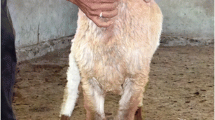Abstract
Previous studies have shown that selenium (Se) deficiency is associated with nutritional myopathy, known as white muscle disease (WMD), in horses. However, correlations between Se deficiency and clinical findings, such as hematologic biochemical values and pathological features, have not been evaluated in captive plains zebras. The purpose of the present study was to investigate the clinical and pathologic features that may be caused by a Se deficiency in the captive plains zebra. Clinical findings, feed analyses, hematologic biochemical analyses, response to treatment, and pathologic examination were assessed in six affected plains zebras. The dietary concentration of Se in feed was also tested. Sudden death occurred in two cases during the first day of the onset of symptoms. Two zebras died at 4 days and two zebras survived after treatment. The clinical signs in affected animals were characterized by general weakness, astasia, and abnormal postural positions. The Se concentration in hay from the breeding stable was low, based on the reference value. Glutathione peroxidase (GSH-Px) activity was lower compared with the equine reference value. Multiple areas of subcutaneous steatitis and pale skeletal muscle and myocardium were revealed at gross necropsy. Degeneration and necrosis of myocardial and skeletal muscles, as well as congestion of the liver, lung, and kidney were found via histopathological examination. No suspected bacterial infections were found. Feed analyses, response to treatment, serum GSH-Px activity, and pathological features suggest that Se deficiency may have caused the disease in the six affected captive plains zebra.



Similar content being viewed by others
References
Navarro-Alarcon M, Lopez-Martinez MC (2000) Essentiality of selenium in the human body: relationship with different diseases. Sci Total Environ 249(1–3):347–371
Wilson TM, Morrison HA, Palmer NC, Finley GG, van Dreumel AA (1976) Myodegeneration and suspected selenium/vitamin E deficiency in horses. J Am Vet Med Assoc 169(2):213–217
Ataollahi F, Mohri M, Seifi HA, Pingguan-Murphy B, Wan Abas WA, Osman NA (2013) Evaluation of copper concentration in subclinical cases of white muscle disease and its relationship with cardiac troponin I. PLoS One 8(2):e56163. doi:10.1371/journal.pone.0056163
Rayman MP (2000) The importance of selenium to human health. Lancet 356(9225):233–241. doi:10.1016/S0140-6736(00)02490-9
Hakkarainen J, Lindberg P, Bengtsson G, Jonsson L (1978) Serum glutathione peroxidase activity and blood selenium in pigs. Acta Vet Scand 19:269–284
Peng LL, Wang XL, Chen X, Dai WH, Gan SJ (2015) Environmental distribution of selenium and its effect on human health (in Chinese). Anhui Journal of Preventive Medicine 21:33–36
Lamprey HF (1963) Ecological separation of large mammal species in the Tangayika Game Reserve, Tangayika E Afr Wildl J 63–93
Montgomery JB, Wichtel JJ, Wichtel MG, McNiven MA, McClure J (2011) The efficacy of selenium treatment of forage for the correction of selenium deficiency in horses. Anim Feed Sci Technol 170(1–2):63–71. doi:10.1016/j.anifeedsci.2011.07.018
Lindner A, Wahdati A, Sommer H (1992) Glutathione peroxidase activity in whole blood and plasma of horses of different ages, sexes and different use. Berliner und Munchener tierarztliche Wochenschrift 105(7):239–242
Lofstedt J (1997) White muscle disease of foals. Vet Clin N Am Equine Pract 13:169–185
Gunes V, Ozcan K, Citil M, Onmaz AC, Erdogan HM (2010) Detection of myocardial degeneration with point-of-care cardiac troponin assays and histopathology in lambs with white muscle disease. Vet J 184:376–378
Loynachan AT (2012) Mulberry heart disease. In: Diseases of swine. 10th ed. Singapore: Blackwell Publishing, pp 192–193
van Vleet JF, Ferrans VJ (1992) Etiologic factors and pathologic alterations in selenium-vitamin E deficiency and excess in animals and humans. Biol Trace Elem Res 33:1–21
National Research Council (U.S.) (2007) Committee on nutrient requirements of horses. Nutrient requirements of horses. 6th rev. ed. Washington National Academies Press, pp 341
Richardson SM, Siciliano PD, Engle TE, Larson CK, Ward TL (2006) Effect of selenium supplementation and source on the selenium status of horses. J Anim Sci 4(7):1742–1748. doi:10.2527/jas.2005-413
Van Vleet JF (1975) Retention of selenium in tissues of calves, lambs, and pigs after parenteral injection of a selenium-vitamin E preparation. Am J Vet Res 36(9):1335–1340
(2000) The mineral nutrition of livestock, 3rd ed. Brit J Nutri 84(3):393
Thompson KG, Fraser AJ, Harrop BM, Kirk JA (1980) Glutathione peroxidase activity in bovine serum and erythrocytes in relation to selenium concentrations of blood, serum and liver. Res Vet Sci 28(3):321–324
Acknowledgments
We would like to thank senior experimentalist Zhigang Han for the food analyses in this study.
Author Contributions
F.C., Y.P., and D.W. designed and performed the experiment, performed data analysis, and wrote the manuscript. J.G., W.H., D.Z., X.B., J.Z., and M.H. participated in the experiment. All the authors have given permission to be named.
Author information
Authors and Affiliations
Corresponding author
Ethics declarations
The ethics committees of Chongqing Medical University and Chongqing Zoo approved the study and allowed collection of blood samples by venipuncture, from the captive plains zebras. All manipulations were conducted in compliance with the ethics committees of Chongqing Medical University and Chongqing Zoo for the humane care and use of animals in research.
Funding
This work was supported by the Scientific and Technological Innovation Special Program of Social Livelihood of Chongqing (Grant No. cstc2015shmszx120031, cstc2015shmszx120017, cstc2015shmszxsydw) and Strategic Emerging Industries Reserve Program of Chongqing Development and Reform Commission (Grant No. [2015] 1650).
Conflict of Interest
The authors declared that they have no conflict of interests.
Rights and permissions
About this article
Cite this article
Chen, F., Gao, J., Wu, D. et al. Clinical and Pathologic Features of a Suspected Selenium Deficiency in Captive Plains Zebras. Biol Trace Elem Res 176, 114–119 (2017). https://doi.org/10.1007/s12011-016-0820-2
Received:
Accepted:
Published:
Issue Date:
DOI: https://doi.org/10.1007/s12011-016-0820-2




